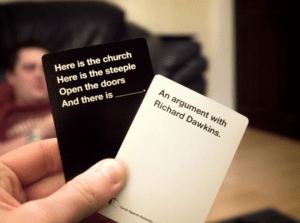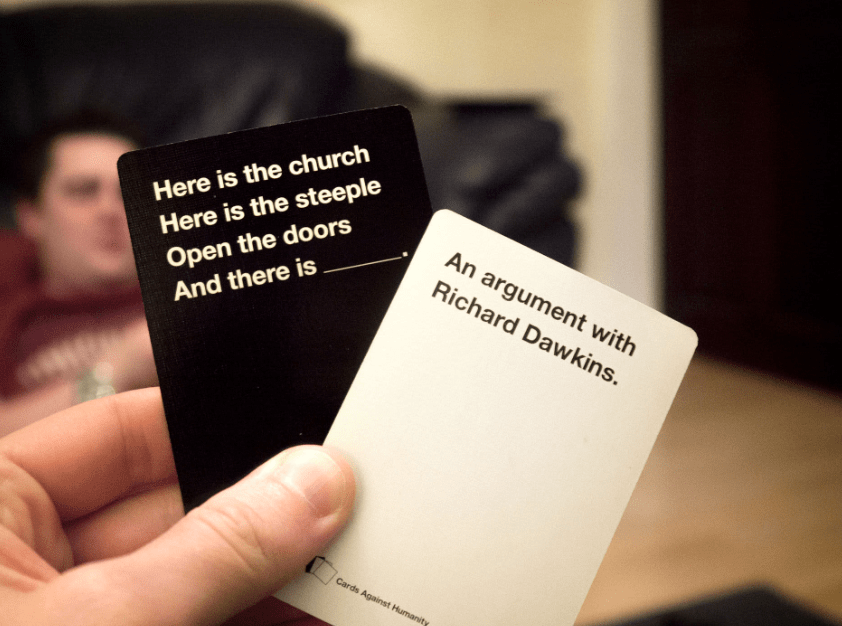
“Cards Against Humanity,” known for its edgy and often risqué content, serves as an intriguing case study in the use of humor to forge and deepen social connections. Created by a group of friends from Highland Park High School, this game thrives among older audiences who appreciate dark humor, as the cards often contain jarring and edgy content that is best shared between close friends. The game is available both as a physical card game and in digital formats, making it versatile for various gathering sizes and environments (I’ve played it at house parties, on long car rides, and at pregames!).
The central mechanic of “Cards Against Humanity” involves players taking turns as the “Card Czar,” judging humor in the responses to prompt cards drawn each round. This mechanic does more than dictate game play. This mechanic allows the criteria of what is funny or best to shift every round, encouraging participants to remain creative every round, and also providing insight into the humor that the “card czar” personally enjoys most.
Each round, players select from their hand of response cards the one they believe the judge will find most amusing in the context of the given prompt. This simple mechanic of choosing and judging cards sets the stage for dynamic social interactions. Players must tap into their understanding of each other’s personalities (particularly that of the person who is judging) and senses of humor, a process that is deeply interactive and often reflective of long-standing relationships. While players will often prioritize creating the card combo that is most funny to themselves, a well-placed reference to a shared inside joke with the “Card Czar” will often win a round. This happened multiple times when I played with friends this past weekend – the jokes that won may not have been the funniest in a vacuum, but they hit the hardest since they referred to shared past experiences. Moreover, in games with my close friends, who have shared countless experiences since our freshman year of college, we often find that the most outrageous or inappropriate cards are not just the most humorous but also the most successful. This success stems from our intricate understanding of what can be shared and laughed about within the safety of our group, where boundaries are well known and respected.
The aesthetic goal of “Cards Against Humanity” is to entertain players by pushing boundaries of comfort and appropriateness. However, the laughter it generates does more than entertain—it connects! As we share laughs over the absurdity of the card combinations (say, a reference to a friend’s unfortunate experience at Enso freshman year), we not only create moments of joy but also reinforce the bonds of our friendship. This shared experience of humor, especially in a familiar group, acts as a powerful social glue, making the game a favorite in settings where deep trust and mutual respect are already established.
When compared to more family-friendly judging games like “Apples to Apples,” “Cards Against Humanity” distinctly encourages players to engage with more controversial topics humorously. Particularly for young people, this approach is more appealing, and also means that the game can be played in a variety of settings ranging from a chill kickback to a rowdy pregame. This engagement often leads to a stronger emotional impact, further developing a sense of camaraderie among players who already feel comfortable sharing and laughing at this kind of content together. Clearly, by designing game mechanics that promote laughter and also the sharing of inside jokes, Cards Against Humanity masquerades as a simple judging game, but actually strongly influences player psychology and ultimately deepen relationships.
However, there are a few suggestions I would make. To enhance its replay value and appeal to a broader audience, “Cards Against Humanity” could introduce varying levels of prompt and response cards, categorized by theme or intensity of content. Perhaps an expansion deck for very dark humor, avid sports fans, or young adults could be added. This modification would allow players to tailor the game’s experience to different comfort levels, making it more inclusive while maintaining its core appeal.



